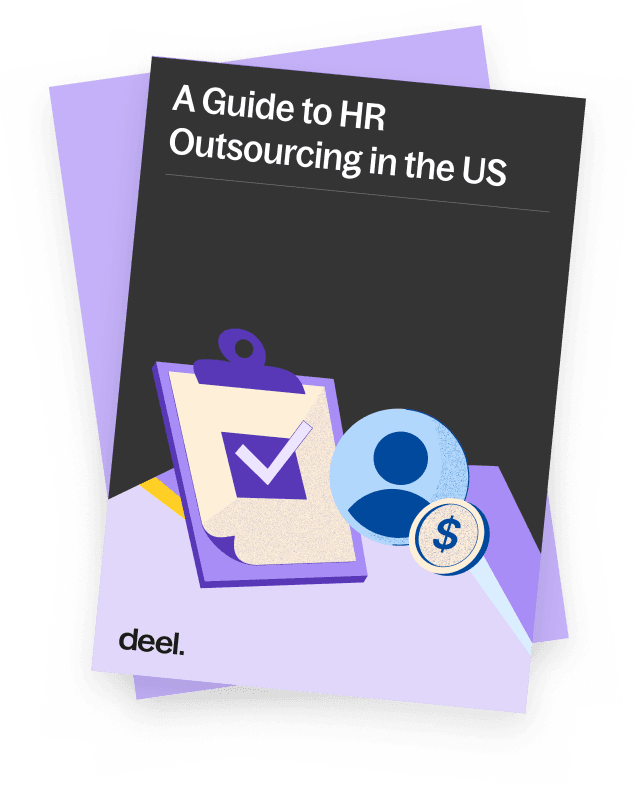Article
11 min read
How to Prepare for Maine's Paid Family Leave in 2026
US payroll
PEO

Author
Shannon Ongaro
Last Update
June 18, 2025

Table of Contents
Maine Family Medical Leave Act (MFMLA): Unpaid leave overview
Maine Paid Family and Medical Leave (PFML) program (effective 2026)
Job protection and non-retaliation
Employer checklist for Maine paid leave compliance
Comparison: Maine Family and Medical Leave (unpaid vs paid)
How Deel PEO simplifies Maine compliance
Key takeaways
-
The upcoming Maine Paid Family and Medical Leave (PFML) law begins collecting payroll contributions in January 2025 and provides paid leave benefits starting May 2026.
-
While MFMLA offers up to 10 weeks of unpaid, job-protected leave every two years, the new PFML program provides up to 12 weeks of paid leave annually for medical, family, and safety-related reasons, with strong job protection for qualifying employees.
-
To stay compliant, employers should update leave policies, prepare payroll systems for PFML contributions, educate employees, and consider using a PEO for streamlined compliance and leave management.
Maine parental leave in 2025 consists of two key parts: an existing unpaid family leave law and an upcoming paid family leave program. If you’re an HR professional managing employees in Maine, you’ll need to navigate both.
Maine’s Family Medical Leave Act (MFMLA) guarantees unpaid, job-protected leave for eligible workers, while Maine is also rolling out a Paid Family and Medical Leave (PFML) insurance program (effective 2026) that will provide paid time off for family and medical reasons.
In this article, you’ll get an overview of Maine’s unpaid and paid leave laws, how they interact with federal FMLA, and what you (as an employer) must do to stay compliant. We’ll also compare the unpaid vs. paid programs and provide guidance on leveraging Deel’s PEO to simplify compliance.
Disclaimer: This article is for informational purposes only and is not legal advice.
Maine Family Medical Leave Act (MFMLA): Unpaid leave overview
Maine’s Family Medical Leave Requirements Act, often called FMLA Maine, is the state’s version of unpaid family and medical leave. It shares the same intent as the federal FMLA but differs in coverage, eligibility, and length of leave.
Covered employers
MFMLA applies to:
-
Private employers with 15 or more employees at one Maine location
-
Public employers, including:
-
All state agencies (regardless of size)
-
Municipalities with 25+ employees
-
Small businesses (<15 employees) are exempt from MFMLA, though their workers may still qualify for federal FMLA if the employer has 50+ employees nationwide.
Employee eligibility
To qualify, an employee must have:
-
12 consecutive months of employment with the same employer
-
No hours-worked requirement, unlike the federal FMLA
Special rule for school employees: They are eligible with 900 hours worked in the past year, mirroring the federal standard.
Duration of leave
Employees may take:
- Up to 10 work weeks of unpaid leave in any 2-year period
This is less generous than the 12 weeks per year allowed under federal FMLA. For example, using 10 weeks in year one exhausts the state entitlement for year two.
Employers can allow more leave voluntarily, but only 10 weeks are required by law.
Qualifying reasons for leave
Leave can be taken for most federal FMLA reasons, plus more:
- The employee’s own serious health condition
- Birth or adoption of a child (adopted children must be under age 16)
- Caring for a family member with a serious health condition, including spouse, child, parent, sibling, grandchild, or domestic partner (and their child/grandchild)
- Organ donation (including recovery time)
- Certain military family needs, including injury or death of a service member
Notable expansion: MFMLA covers domestic partners and extended family, which is a key difference from the federal law, which is more restrictive. For example, MFMLA may cover leave to care for a domestic partner or adult sibling, which the federal FMLA would not.
See also: An Employer's State-by-State Guide to Paid Sick Leave in the US

Notice and certification
Employees must:
- Provide 30 days’ notice for foreseeable leave (e.g., childbirth, scheduled surgery)
Give notice as soon as practicable for emergencies
Employers may:
- Require medical certification from a healthcare provider for health-related leave
- Set up formal procedures (e.g., forms, documentation) for requesting leave
Tip: HR should proactively educate employees about these notice and certification rules to ensure compliance and minimize confusion.
Coordination with the Federal FMLA
When both laws apply, leave runs concurrently:
-
An eligible employee doesn’t get 10 weeks of MFMLA plus 12 weeks of federal FMLA
-
Example: An employee who gives birth may use 10 weeks under MFMLA, which counts toward the 12-week federal FMLA cap, leaving only 2 weeks of FMLA remaining
Employers should designate leave as concurrent to prevent “double-dipping.” (Maine’s new Paid Family and Medical Leave law also confirms this concurrency.)
See also: State-by-State Guide to Maternity Leave in the United States
Job protection
MFMLA provides job protection. Employees must be restored to the same or an equivalent position, with the same:
- Pay
- Employee benefits
- Seniority
- Terms of employment
Employers may not retaliate against employees for taking or requesting leave. Disciplinary actions (e.g., terminations or demotions) tied to protected leave are unlawful unless the employer can demonstrate legitimate, unrelated reasons, which is an evidentiary burden that’s hard to meet.
See also: At-Will States: Employer Rights, Termination Laws, and Compliance
Benefits during leave
Though MFMLA is unpaid:
-
Employees may elect (or be required) to use accrued paid leave (vacation, sick time) concurrently
-
Employees must be allowed to continue existing benefits, like health insurance, at their own cost
- You must offer continued coverage as if the employee were still working, provided they pay their portion
- This differs slightly from the federal FMLA, which requires maintaining benefits at the same employer/employee contribution rates
Employees do not lose any previously earned benefits (like paid time off (PTO), seniority) by taking leave.
Employer action steps
To comply and reduce risk, update your employee handbook to:
- Outline eligibility requirements
- Explain the 10-week/2-year limit
- Clarify the application and certification process
- State that MFMLA leave will run concurrently with federal FMLA, where applicable

Free guide
A Beginner’s Guide to HR Outsourcing
Maine Paid Family and Medical Leave (PFML) program (effective 2026)
Maine has enacted a statewide Paid Family and Medical Leave (PFML) insurance program, adding paid leave benefits to complement its unpaid leave law. Signed in 2023, this law makes Maine the 13th state with a paid leave system.
While benefits begin in May 2026, employer payroll contributions start in January 2025, so preparation in 2025 is critical.
Key dates and implementation timeline
- Law enacted: October 2023
- Payroll contributions begin: January 1, 2025
- Paid benefits available: May 1, 2026
Employees may apply for paid leave starting May 2026 for qualifying absences that occur on or after that date. The 2025 payroll contributions are meant to fund the system before benefit payouts begin.
Action item: Begin withholding and remitting premiums in Q1 2025. Benefits cannot be claimed until May 2026.
Covered employers
All employers with at least one Maine-based employee must participate, as there’s no size exemption. Key requirements:
-
Out-of-state employers with Maine employees must also register and contribute
-
Tribal governments and self-employed workers may opt in voluntarily
-
The state will provide an online portal for:
- Employer registration
- Quarterly wage reporting
- Contribution payments
Payroll contributions
The program is funded through payroll premiums split between employers and employees, depending on employer size:
For employers with 15+ employees (nationwide):
-
Total premium: 1.0% of Maine wages
- Up to 0.5% withheld from employee wages
- 0.5% paid by employer
For employers with <15 employees:
-
Total premium: 0.5% of Maine wages
-
Entire amount can be withheld from employee wages
-
Employer contribution optional
-
Employers may choose to cover more than their required share. All contributions go into the state PFML fund for 2026 benefits.

Guide
Expanding your business in the US?
Employee eligibility for benefits
To qualify for paid benefits starting in 2026, workers must:
-
Be a covered individual (earned at least six times the State Average Weekly Wage during the base period—generally ~$6,000–$8,000)
-
There is no minimum tenure, so new employees may qualify after a few months of work if they meet the earnings threshold
-
For job protection, however, an employee must have 120 days of employment before taking leave
Union exception: Employees covered by a collective bargaining agreement (CBA) as of October 2023 are excluded until the CBA expires.
Qualifying leave reasons
Maine’s PFML covers both Family Leave and Medical Leave, with a broader scope than the federal FMLA.
Family Leave (Paid):
-
Bonding with a newborn or newly placed child (adoption/foster care) within 12 months
-
Caring for a family member with a serious health condition (includes spouse, parent, child, sibling, domestic partner, grandchild, etc.)
-
Military exigencies (deployment-related needs, or caregiving for an injured service member)
-
Safe leave for domestic violence, sexual assault, or stalking (includes medical, legal, or safety-related actions)
-
Any reason covered by MFMLA, including organ donation and death/serious injury of a family member on active military duty
Medical Leave (Paid):
- The employee’s own serious health condition that prevents them from working (e.g. surgery, illness, pregnancy complications)
Amount of leave and wage replacement
Leave duration: Up to 12 weeks of paid leave per benefit year.
-
Includes any mix of family and medical leave
-
No stacking—an employee cannot exceed 12 weeks total per year
-
Exception: Pregnancy-related medical leave can directly transition into parental leave, but total paid time remains capped at 12 weeks
Wage replacement formula:
-
90% of weekly wages up to 50% of the SAWW
-
66% of wages above that threshold
-
Maximum benefit: 100% of SAWW (adjusted annually)
Example: If SAWW is $1,000, the maximum weekly benefit is $1,000. Lower earners will receive close to full wage replacement; higher earners receive less due to the cap.
-
A seven-day waiting period applies to medical leave (not family leave). Employees may use PTO during this week
-
Intermittent leave is prorated accordingly
Continuous Compliance™
Job protection and non-retaliation
PFML includes strong job protection and anti-retaliation provisions:
-
Employees are entitled to reinstatement to the same or equivalent position if they’ve worked at least 120 days before leave
-
Employers must maintain health benefits under the same terms during leave (like FMLA)
-
Retaliation or discrimination for taking PFML leave is strictly prohibited
Even small employers not previously covered by FMLA or MFMLA are now required to provide protected leave if employees qualify for benefits.
PFML interaction with FMLA and MFMLA
Maine’s PFML is designed to run concurrently with both:
-
Federal FMLA (if the employer is covered and the employee is eligible)
-
Maine MFMLA (state unpaid leave)
This prevents “double-dipping.” If an employee takes 12 weeks of PFML, it counts toward their FMLA and MFMLA entitlements.
However, if the employee isn’t eligible for FMLA (e.g., works <12 months or employer <50 employees), they can still use PFML independently. In this case, only PFML rights apply.
Deel PEO
Employer checklist for Maine paid leave compliance
To stay compliant and support your workforce:
- Register for the Maine Paid Leave portal
- Set up payroll deductions and contributions
- Update leave policies to reflect PFML and its interaction with FMLA/MFMLA
- Communicate the benefit clearly to Maine employees
- Train managers on eligibility, reinstatement rights, and benefit protections
By integrating PFML into your 2025 planning, you’ll be positioned to support employees while ensuring compliance in 2026.
Comparison: Maine Family and Medical Leave (unpaid vs paid)
| Feature | MFMLA – Unpaid Leave | PFML – Paid Leave (Starting 2026) |
|---|---|---|
| Employer Coverage | ≥15 Maine employees; public employers | All with ≥1 employee |
| Employee Eligibility | 12 months service | ~6x SAWW in earnings; 120 days for job protection |
| Leave Duration | 10 weeks per 2 years | 12 weeks per year |
| Pay Status | Unpaid | Paid via state fund |
| Qualifying Reasons | Health, family care, adoption, military, and organ donation | Same + bonding, safe leave, military exigency |
| Job Protection | Yes (eligible employees) | Yes (after 120 days) |
| Interaction with FMLA | Runs concurrently with FMLA (if both apply) | Also runs concurrently with FMLA and MFMLA, where applicable |
How Deel PEO simplifies Maine compliance
Managing both MFMLA and PFML requirements can be time-consuming. A professional employer organization (PEO) provides the tools and expertise to make compliance seamless.
With Deel PEO, you benefit from:
- Automated payroll with PFML contribution tracking
- Leave management tools aligned with federal and state law
- Policy documentation updates for MFMLA, PFML, and FMLA
- On-demand compliance support across all US states
Whether you’re hiring your first employee in Maine or scaling a distributed team, Deel PEO helps you meet legal obligations and support employee well-being.
Want to simplify leave compliance in Maine? Book a demo to speak with an expert about how Deel PEO can help you hire, pay, and manage workers in Maine, across the US, and globally.

Shannon Ongaro is a content marketing manager and trained journalist with over a decade of experience producing content that supports franchisees, small businesses, and global enterprises. Over the years, she’s covered topics such as payroll, HR tech, workplace culture, and more. At Deel, Shannon specializes in thought leadership and global payroll content.













